#samadhi
Text
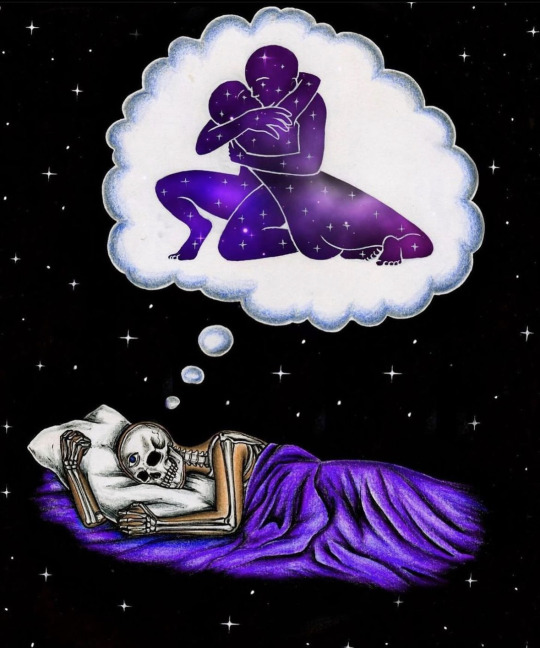
Chase …….Attract
#monsterohnenamen#monster#soul mates#soulmates#law of attraction#manifesation#spiritualhealing#spiritualjourney#spirituality#spiritual quotes#twin flame#soul connection#soul art#third eye#samadhi#higher mind#thoughts
91 notes
·
View notes
Note
So, what IS the Samadhi Fire/True Fire of Samadhi? It can't be an average flame if it can take out Sun Wukong himself in JttW and the name sounds like it means something, but I can't find any context when I look it up.
Journey to the West states that Samādhi fire is not like earthly or heavenly flame. It is something more. Part of a poem in chapter 41 reads:
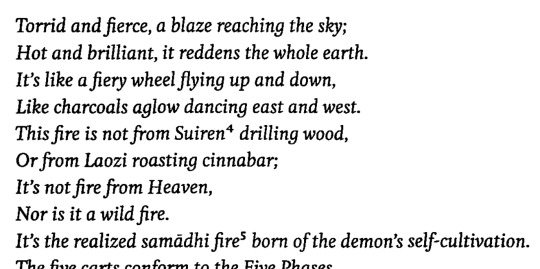
(Wu & Yu, 2012, vol. 2, p. 225)
The general concept of Samādhi (Sk: "concentration"; Ch: sanmei, 三昧) refers to an advanced level of meditation where one can "establish and maintain one-pointedness of mind on a specific object of concentration" (Buswell & Lopez, 2014, p. 743). Some Hindu and Buddhist sources associate it with a spiritually cleansing flame. One example comes from the Gaṇḍavyūha section of the Avataṃsaka Sūtra (Ch: Dafang guangfo huayan jing, 大方廣佛華嚴經; compiled by the 3rd or 4th-century CE).
Sudhana (Ch: Shancai tongzi, 善財童子; i.e. Red Boy), the holy work's protagonist, seeks out 53 teachers in the course of his spiritual cultivation. His ninth instructor, a learned Brahmin named Jayoṣmāyatana (Ch: Shengre poluomen, 勝熱婆羅門; lit: "Victorious Heat Brahmin") is said to have achieved "the light of the concentration [i.e. Samādhi] of adamantine flame" (jingang yan sanmei guangming, 金剛焰三昧光明) (Clearly, 1993, p. 1218). The fire that he produces is so powerful that it scares even the gods and demons. Though, the point of the flames appears to be incineration of the ego and desires and illumination of the mind. Sudhana follows his instructions by throwing himself into the fire, thus gaining a higher level of spiritual knowledge.
Here is a translation of that section of the sutra (warning: it is wordy):
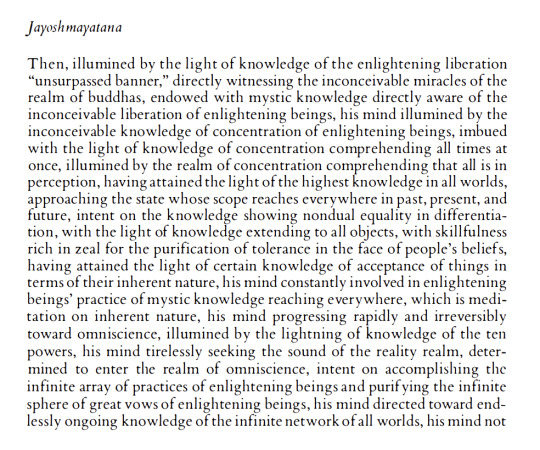

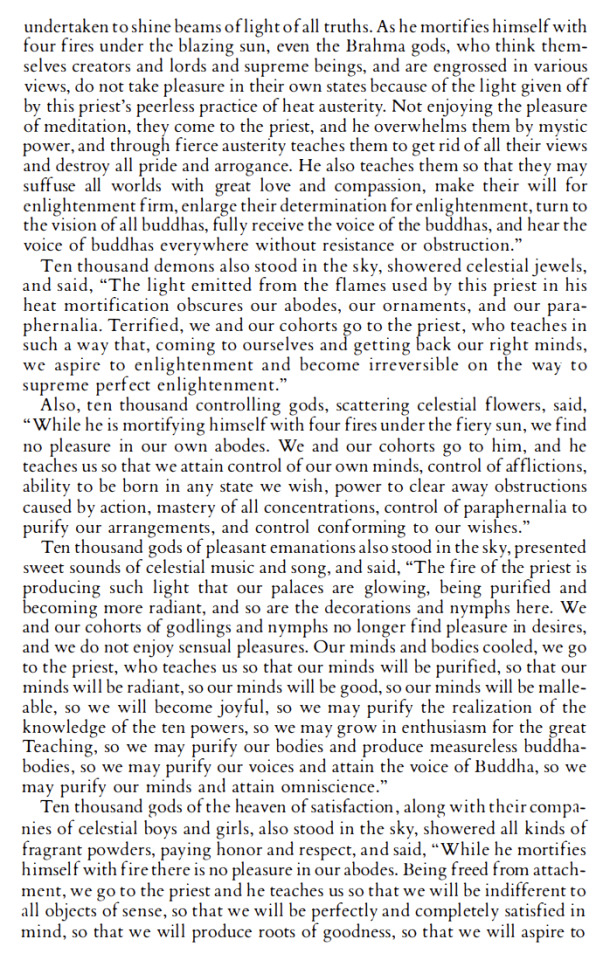
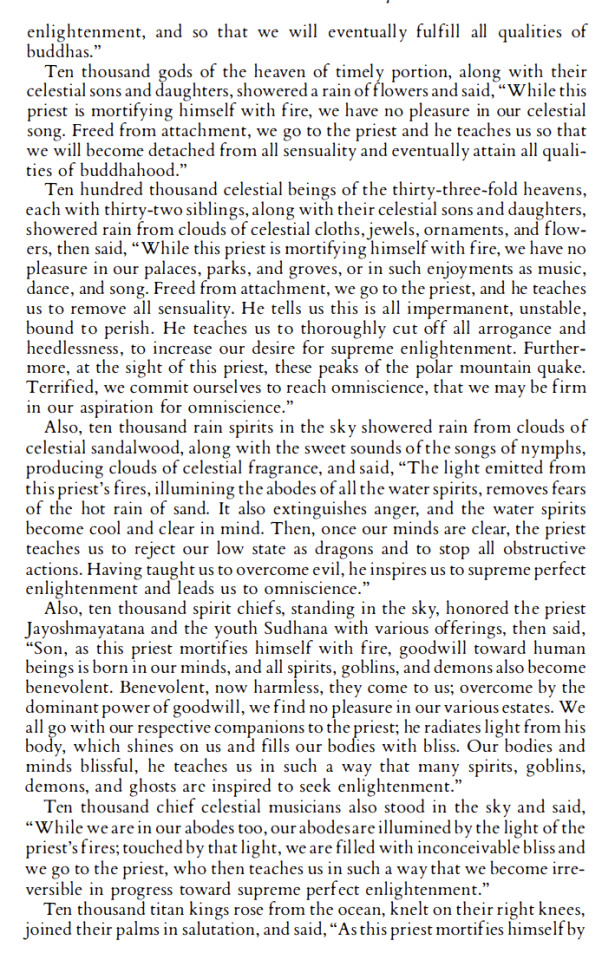
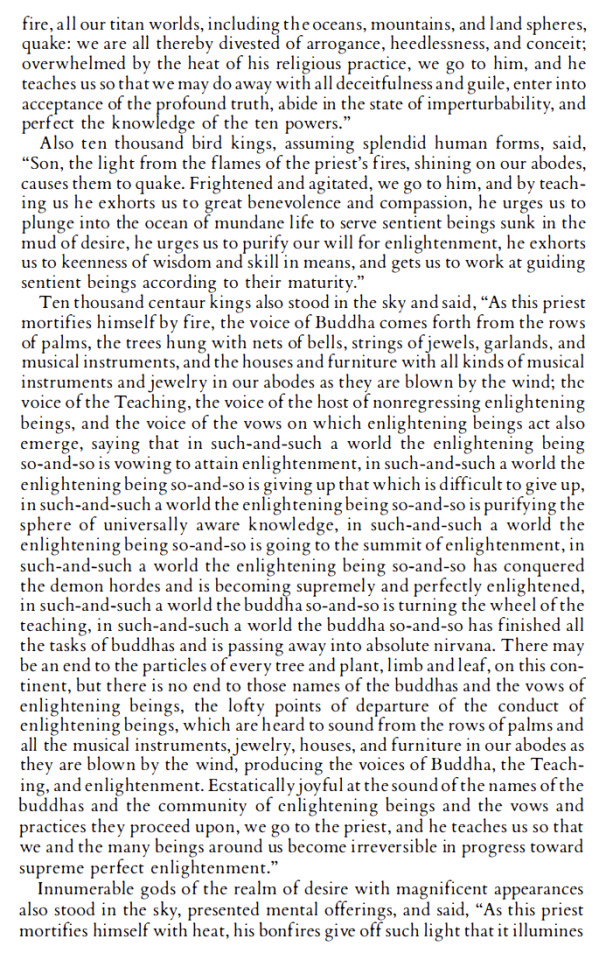
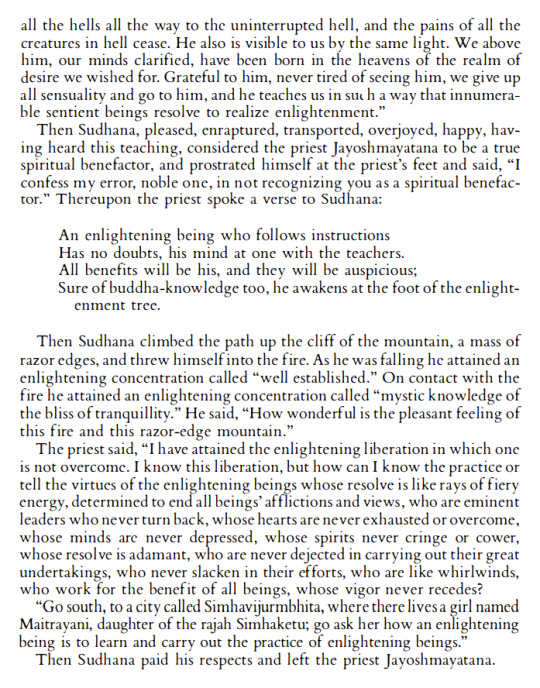
(Clearly, 1993, pp. 1217-1222)
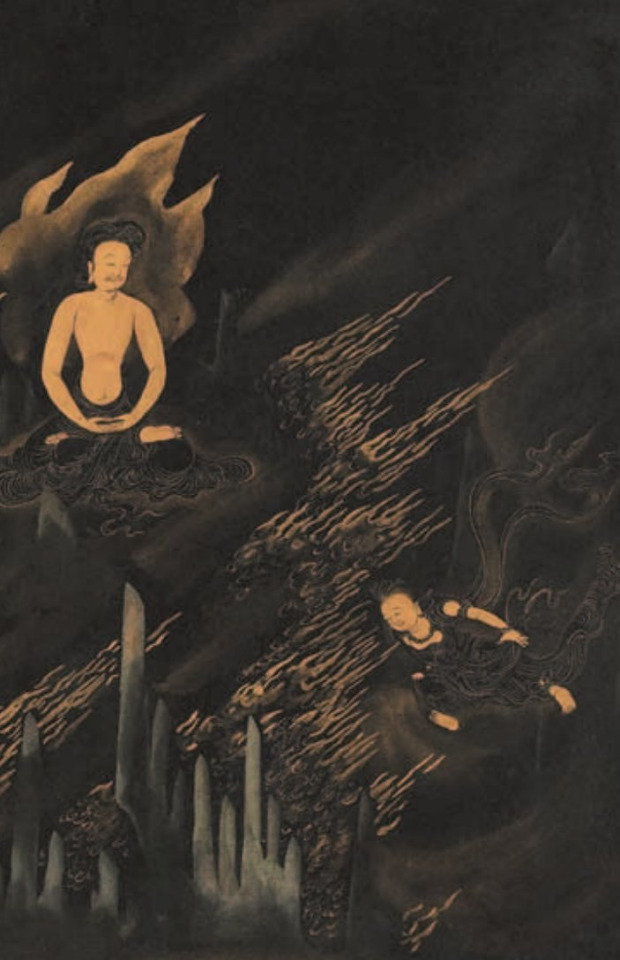
A Song or Ming-era Japanese painting of the fire brahmin and Sudhana.
Sources:
Buswell, R. E. , & Lopez, D. S. (2014). The Princeton Dictionary of Buddhism. Princeton University Press.
Cleary, T. (1993). The Flower Ornament Scripture: A Translation of the Avatamsaka Sutra. Boston: Shambhala.
Wu, C., & Yu, A. C. (2012). The Journey to the West (Vols. 1-4) (Rev. ed.). Chicago, Illinois: University of Chicago Press.
#Samadhi fire#Samadhi flame#Red Boy#Red Son#Journey to the West#JTTW#Buddhism#Hinduism#Samadhi#Lego Monkie Kid#Sudhana#Shancai tongzi#Chinese religion#Indian religion#meditation
97 notes
·
View notes
Text


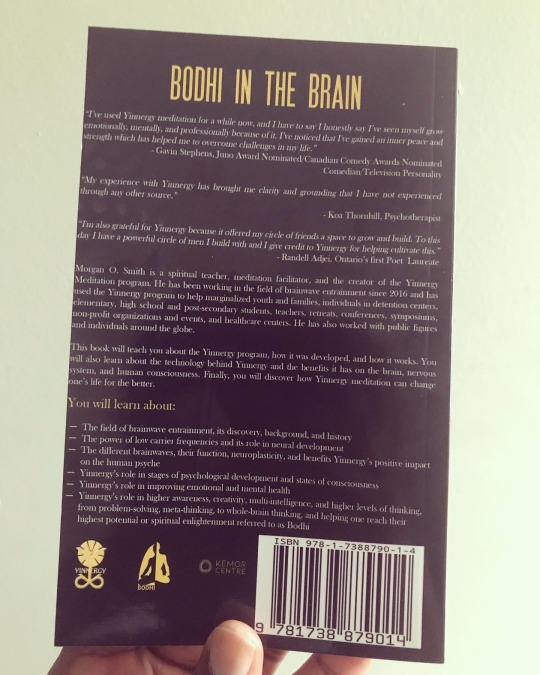
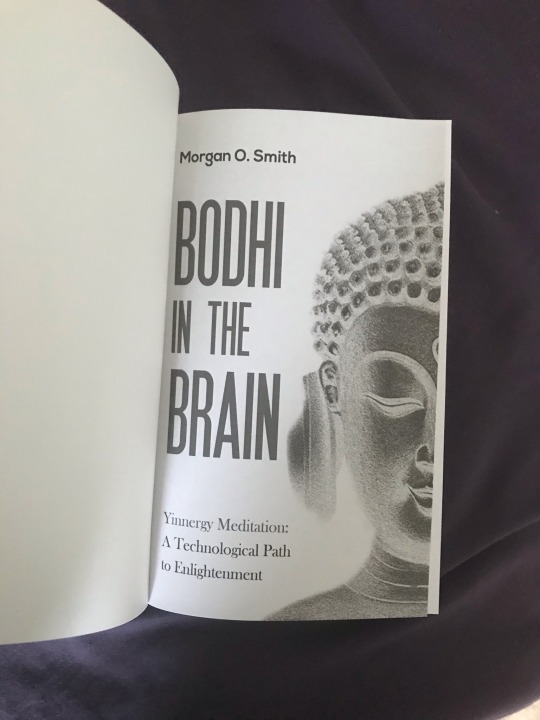
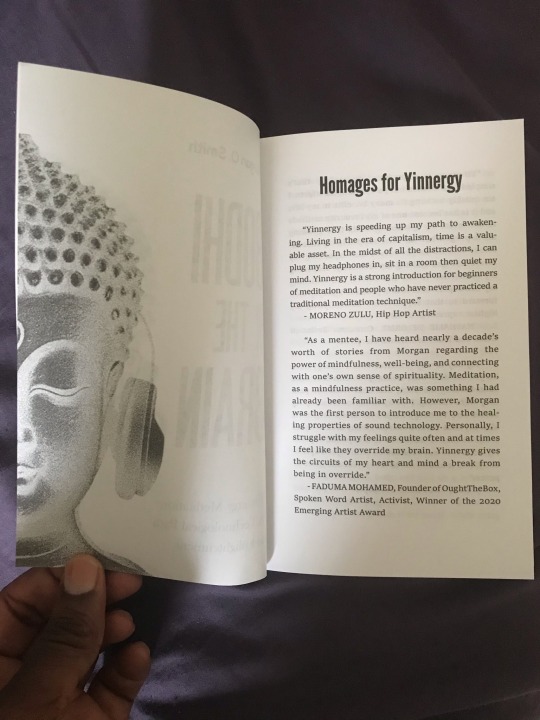
After over a decade of persistence and dedication, my labor of love, "Bodhi in the Brain," has finally come to fruition. This milestone marks the first of the 13 books I aim to write and publish in my lifetime, leaving 12 more compelling journeys to undertake. With a heart full of gratitude, I invite you all to join me on this journey and send your good luck wishes my way.
I am eternally grateful to everyone who contributed to this project. A special thanks to the participants of the Yinnergy meditation program for their invaluable feedback and testimonials, the talented artists who breathed life into the book through stunning design and captivating photography, and the diligent researchers and formatters who ensured every detail was perfect.
Lastly, but certainly not least, my profound gratitude goes to my editor, Nathalie Delorme, for her unwavering support and expertise. Thank you, Nathalie, for encouraging me to weave this story and for your meticulous editing.
Here's to the road ahead - may it be filled with creativity, inspiration, and a whole lot of writing!
Adding a special note of gratitude for Keda Edwards Pierre, who graciously penned the foreword for "Bodhi in the Brain". Her eloquent words provide a beautiful introduction to the journey readers are about to embark on. Thank you, Keda, for enriching the book with your wisdom.
Bodhi in the Brain, paperback or ebook. Buy Now!
youtube
youtube
youtube
#meditation#spiritualenlightenment#spiritualawakening#nonduality#mindfulness#spiritualgrowth#consciousliving#spiritual practices#brainwave entrainment#samadhi#brahman#higherconsciousness#kundalini#spirituality#spiritual#Youtube
164 notes
·
View notes
Text

Early Buddhist depiction of a bodhisattva with lotus (padma) in hands.
#buddhism#buddha#mahayana#blue#vajrayana#nirvana#samadhi#meditation#cave paintings#padma#lotus#dukkha#bodhisattva#☸️
12 notes
·
View notes
Text
Can somebody explain to me why Wukong needs to use the Samadhi Fire to kill LBD? Like I get his reason but why? What could the fire do that it is specifically needed for this situation. (I know he basically overpowers her in the special but ignore that.)
I came up with something lame like, "He uses the fire so he could burn her from existence because he's tired of her resurrection bs."
There's nothing in the show that explains why Wukong needs to use the fire. (Unless there was something and I completely missed it.)
I wanna know the opinions and head cannons of others and it also gives me the opportunity to connect with the fandom.
So please reblog this with your thoughts and theories I would love to see what you guys think.
32 notes
·
View notes
Text
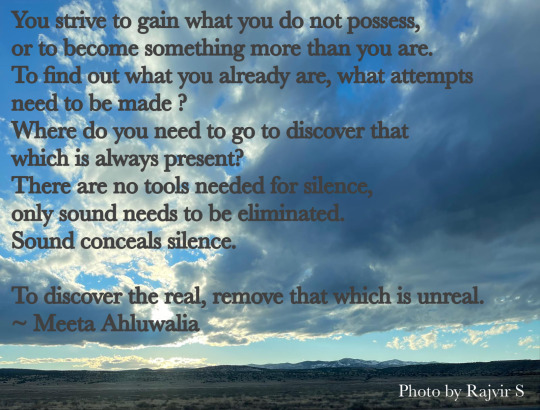
#meeta ahluwalia#meetaahluwalia#spirituality#writers on tumblr#writers and poets#zen#meditation#silence#consciousness#samadhi
19 notes
·
View notes
Photo

The Quest for Buddhism (109)
Buddhist cosmology
Mental Factors in Buddhism - The relationship between Panchangika and the 5 hindrances
The Panchangika(Ref3), which are the components of the Mental Factors (Skt: caitasika, Pali: cetasika Ref2) in the Rupa-jhana(Ref), and the five Hindrances (Ref4), which are the mind poisons that hinder them, are just in a trade-off (interchangeable) relationship.
The correspondence between the Panchangika and the 5 Hindrances is as follows:

Therefore, by suppressing the five hindrances through the 4 immeasurable minds (“meditation on compassion”) and the Buddhanussati ("Buddha-mindfulness"), while at the same time raising the panchangika, it then becomes easier to enter into jhana as ‘upacara-samadhi’ as wll as ‘appana samādhi’ which is the complete immersion of the mind in the meditation on the object and the stability of all 4 rupa jhana.
Buddhanussati (Skt: Buddhanusmrti), meaning "Buddha-mindfulness", is a common Buddhist practice in all Buddhist traditions which involves meditating on the virtues of the Buddha, mainly Gautama Buddha as the meditation or contemplation subject. Upacara-samadhi is a state of concentration in Theravada Buddhism that is equivalent to zen meditation (jhana Ref5). It is one of the Rupa-jhana (samadhi).

仏教の探求 (109)
仏教の宇宙論
心所(しんじょ)〜 五禅支と五蓋の関係
四禅 (しぜん、梵: ルーパデイヤーナ参照)における心所 (しんじょ、梵: チャイタシカ、巴: チェータシカ参照2)の構成要素である五禅支(ごぜんし、梵: パンチャンギガ参照3)と、その妨げとなる煩悩としての五蓋 (ごがい、巴: パンチャ・ニーヴァラナーニ 参照4)は、ちょうど、入れ替えの関係にある。
五禅支と五蓋の対応関係は、以下の通り:

したがって、四無量心 (しむりょうしん、梵: アプラマーニャ, 巴: アッパマナー、「慈悲の瞑想」) や仏隨念 (ぶつずいねん、梵:ブッダーヌッサティ、「仏心」) などによって五蓋 (ごがい)を抑えつつ、五禅支(ごぜんし)を高めていくことで、近行定 (きんぎょうじょう、巴:ウパチャーラ・サマーディ)、そして安止定 (梵: アッパーナ・サマーディ=対象の瞑想に心を完全に没頭させ、四禅すべてが安定している状態) としての禅定 (梵: デイヤーナ、巴: ジャーナ参照5)に入って行きやすくなる。
仏隨念 (ぶつずいねん)とは、瞑想または観想の対象として主にゴータマ仏陀の美徳を瞑想する、すべての仏教の伝統に共通する修行法のことである。近行定 (きんぎょうじょう、巴:ウパチャーラ・サマーディ)とは、上座部仏教において、禅定 (梵: デイヤーナ、巴: ジャーナ) に準じる集中状態のこと。定 (じょう、巴、梵: サマーディ) の四段階のひとつである。
#zen#mindfulness#buddhism#dhyana#jhana#rupa-jhana#meditation#buddhist cosmology#samadhi#panchangika#5 hindrances#philosophy#nature#art#mindset
133 notes
·
View notes
Text
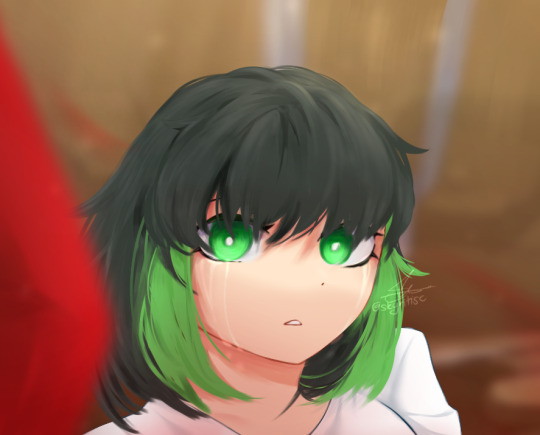
Samadhi incident
#lego monkie kid#lego monkey kid fanart#lego monkie kid mei#monkie kid#monkie kid mk#lmk fandom#lmk fanart#lego monkie kid fanart#monkie kid fanart#samadhi#samadhi fire#lmk mei#mei lmk#monkie kid mei
79 notes
·
View notes
Text
Book of the Day - Yoga Sutras of Patanjali
Today’s Book of the Day is Yoga Sutras, written by Patanjali around the 2nd century BCE.
Patanjali – पतञ्जलि, also called Gonardiya or Gonikaputra, was a Hindu author, mystic, and philosopher, who was believed to be a Siddhar, an enlightened scholar of Yoga and spiritual knowledge. He lived between the 2nd and 4th centuries CE.
I have chosen this book because people often ask me which kind of…

View On WordPress
#Asana#Ashtanga#Ashtanga Yoga#Dharana#Dhyana#Eight Limbs#Kaivalya#meditation#Niyama#Patanjali#Patanjali&039;s Ashtanga Yoga#Prakṛti#Pranayama#Purusha#Raffaello Palandri#Raffaello Palandri Yoga#Samadhi#Tantra#Yama#Yoga#Yoga Sutra
33 notes
·
View notes
Text
On Metacognition, Samadhi, Sadhana and the Places In Between:
The psychologization of the dharma in the west has not been an entirely negative movement. In many ways the marriage of psychology and mindfulness has been a fruitful one that has made Buddhist principles more accessible to the masses. Certainly the ongoing dialogue between observational science and Buddhist spiritual practice has helped to both verify and refine the transmission and translation of various doctrines and practices into a culturally accessible format.
However, this hasn’t been a movement without shadow. The conflation of the dharma with mindfulness alone, as the crown jewel of the psychological reductionist perspective has been a hindering force for many practitioners, who often come to conflate awakening with metacognitive awareness. That’s a grave mistake.
The dawning of metacognition is a substantial doorway, but a doorway nonetheless. It’s not the path made manifest. Likewise practice cannot be reduced to metacognition. Metacognition is a relatively early consequence of meditative practice, but it’s not samadhi, and it’s certainly not prajna.
Samadhi is often misunderstood as some kind of blank absorption into mindless being. This is a substantial pitfall, a trapping of the mind that the ego is all too happy to allow the practitioner to become infatuated with. Hanging out in “nothingness” after all is a safe space for the ego, wherein subject-object dualism can be safely maintained. After all, samadhi as it is most frequently reported is a state of “I” slipping away for a time, after which it can emerge from its bath in nothingness fully aware of its journeying, and often proud of it to boot.
True samadhi on the other hand, true meditative absorption into the heart of reality, is a manifestation of nondualism. It is the realization and effortless expression of subject-object sameness, and embodying of the true-self, which is limitless in time and space, while somehow yet identifiable through the singular body of one’s birth (after all, form IS emptiness and emptiness IS form). It is from this samadhic state that prajna, or the spontaneous expression of wisdom before thinking, can appear.
Zen Master Seung Sahn often noted that practitioners must find “correct situation, correct relationship, and correct function.” Situation, relationship, and function in spontaneous harmony and accord is, in effect, prajna arising from samadhi.
In this it may he further understood that samadhi is not a drop into some well of neutral blankness, but a conscious swim in-and-as the dynamic tension that may be interpreted through such terms as rupa and sunyata, purusha and prakriti, yin and yang, waves and particles, etc.
It is not with any degree of levity that Zen prescribes the essentials of great faith, great doubt, and great determination. We must have some degree of considerable degree of faith that our practice can yield resolution to the matter of life and death. We must uphold a continual resolve to push beyond the limits of what we hope to be the end of the path and into the real, doubting that the full picture has ever quite entered our conscious regard. And too, we must devote ourselves to persistence in this faith and doubt, understanding sadhana (shugyo) as the only path to true liberation and awakening.
~Sunyananda
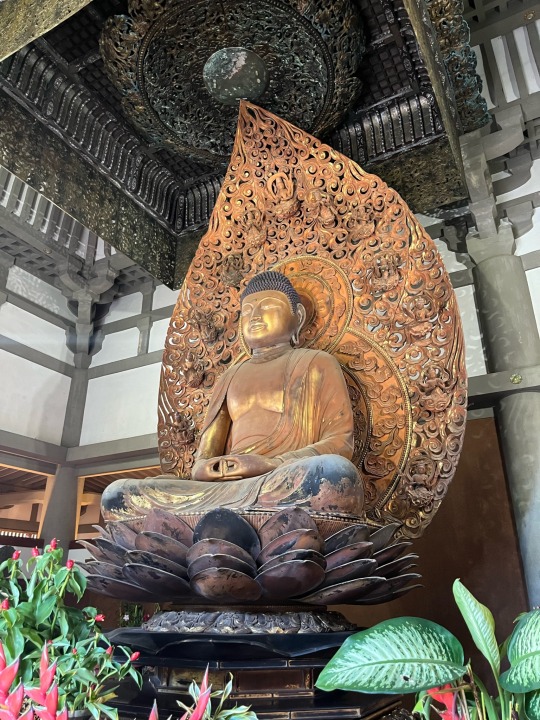
#zen#buddhism#buddha#buddhist#dharma#enlightenment#sangha#awakening#nirvana#spirituality#samadhi#sadhana#shugyo#prajna#Psychology#mindfulness#metacognition
11 notes
·
View notes
Text
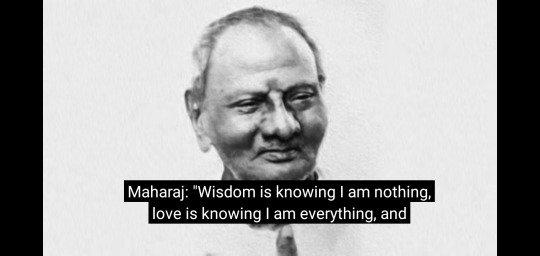

Clip of Sri Nisargadatta Maharaj, from the Samadhi movie on YouTube (available in several languages)
#txt#sri nisargadatta maharaj#nonduality#samadhi#true being#mindfulness#meditation#mindsets#consciousness#awareness#spirituality#yoga#states of consciousness
69 notes
·
View notes
Text
Occult/Hidden Knowledge Asteroids

(2598) Merlin- Initial magical talents and abilities
(2) Pallas- Your 3rd eye; Sense of justice; Strategizing skills; Intellect
(11518) Jung- Your aptitude for psychology and how well you can access the subconscious
(1488) Aura- The type of energy you give off to people the more they get to know the deeper parts of you
(5239) Reiki- Your aptitude for energy work
(30) Urania- Your aptitude for astrology, astronomy or any kind of study of stars
(432) Pythia- Your psychic abilities
(114) Kassandra- Information you have access to that others don’t have and don’t believe you about even though you are right
(5264) Telephus- Intuitive knowing or telepathy skills
(12472) Samadhi- Growth through meditation; Enlightenment
(50000) Quaoar- Your spiritual experiences
(3695) Fiala- Spiritual Vision
copy paste: (2598,2,11518,1488,5239,30,432,114,5264,12472,50000,3695)
#merlin#pallas#jung#aura#reiki#urania#pythia#kassandra#telephus#samadhi#quaoar#fiala#astrology#occult knowledge
100 notes
·
View notes
Text
The Origins of Red Boy
I believe I have found the origins of Red Boy (Hong hai'er, 紅孩兒), his name, and his fire powers from Journey to the West (Xiyouji, 西遊記, 1592). I plan to write an article for my research blog, but it probably won't be until next year. Until then, I want to post my findings here for all to read.
Although the 1592 edition of Journey to the West casts Red Boy as the son of Princess Iron Fan (Tieshan gongzhu, 鐵扇公主), an early-Ming zaju play that predates the novel says his mother is the demon goddess Hārītī (Guizimu, 鬼子母).

A 1st-century BCE Gandharan statue of Hārītī.
Scene 12 of the zaju play sees the Buddha trap Red Boy under his alms bowl in order to force Hārītī to mend her evil ways and convert to Buddhism. This story comes directly from Buddhist canon. Various sources tell how the demoness ate the children of untold numbers of human women, who eventually sought out the Buddha. The Enlightened One knew that Hārītī herself was the mother of 500 (or more) demon children and also that the youngest of them, a boy named either "Pingala" or "Priyankara" (sources vary), was her favorite. One version of the story ends with the demoness converting to Buddhism in order to save her beloved child, who had been hidden under the Buddha's alms bowl. Therefore, Red Boy can confidently be traced to Pingala-Priyankara.

A sketch of the Buddha's alms bowl.
The name Red Boy has puzzled me for some time, but thanks to art sent to me by an expert on Hārītī, I was able to crack the case. Some art shows Hārītī's son wearing red clothing—i.e. a "Red Boy".
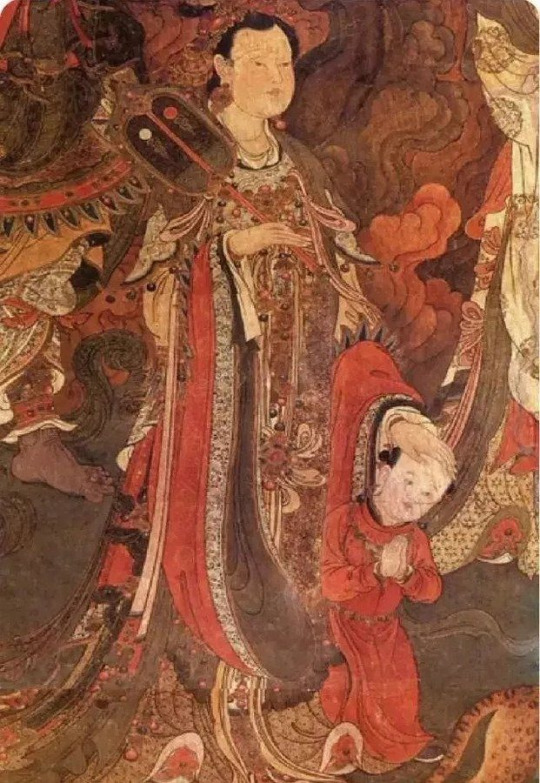
Detail from a 1440s temple mural depicting Hariti and her red-clad son.
The early-Ming zaju play doesn't associate Red Boy with fire. This appears to be a product of the 1592 edition. The novel calls his power "True Samādhi Fire" (Sanmei zhenhuo, 三昧眞火). It's so powerful that nothing short of Guanyin's holy dew can extinguish it. So where did his power come from?
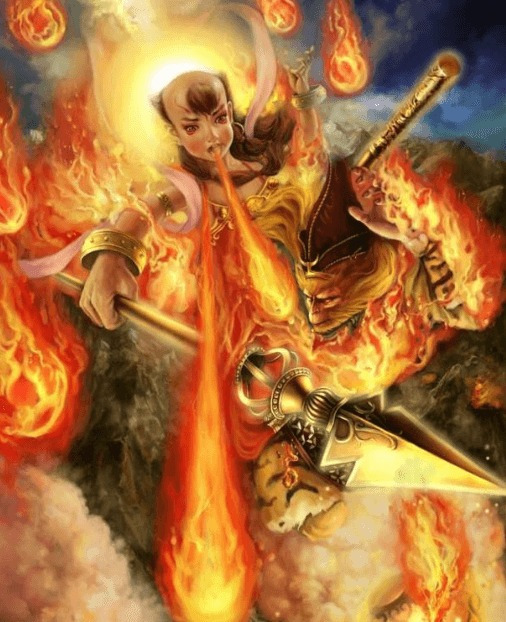
A modern drawing of Red Boy's fire powers.
Journey to the West (1592) states that Guanyin gives Red Boy the religious name "Boy of Goodly Wealth" (Shancai tongzi, 善財童子) after he submits to Buddhism. This is the Chinese name of "Sudhana", a child cultivator famous for studying under 53 divine and mortal masters in the Gaṇḍavyūha Sūtra (c. 200-300).

An 11th or 12th-century print of Sudhana (left) and one of his teachers (right).
Sudhana's ninth teacher, Jayoṣmāyatana (Shengre poluomen, 勝熱婆羅門), likely influenced Red Boy's fire powers. The brahmin is said to wield a fearsome holy fire called the "Samādhi light of adamantine flame" (Jingang yan sanmei guangming, 金剛焰三昧光明). It's so powerful that it scares even the gods and demons, but it's true purpose is to incinerate the ego and enlighten the mind. Sudhana comes one step closer to enlightenment by jumping into the flames as instructed.

A Song or Ming-era Japanese painting of the fire brahmin and Sudhana.
The Gaṇḍavyūha Sūtra mentions that Jayoṣmāyatana practices extreme fire austerities on a flaming mountain. This is interesting because, despite Hārītī being Red Boy's mother in the early-Ming zaju play, Princess Iron Fan and the Flaming Mountain episode do appear later in scenes 18 to 20 of the production. Therefore, the author-compiler of Journey to the West (be it Wu Cheng'en or otherwise) could have combined the similar elements from each story, making Red Boy-Sudhana the son of Princess Iron Fan and giving him the brahmin's fire powers.

A 20th-century postcard depicting a battle between Princess Iron Fan and the Monkey King.
#Red Boy#Red Son#Journey to the West#JTTW#Princess Iron Fan#Hariti#Guizimu#fire powers#super powers#Samadhi#Lego Monkie Kid#Demon Bull King#Bull Demon King#research#Sun Wukong#Monkey King
112 notes
·
View notes
Text
A man in samadhi is no longer of this world.
He may be in this world, but he is no longer of this world.
He may walk on this earth, but he no longer walks on the earth It is said about the man of samadhi he lives in the world but the world does not live in him.
OSHO
2 notes
·
View notes
Text

Paranirvana of Sakyamuni Buddha.
14 notes
·
View notes
Text
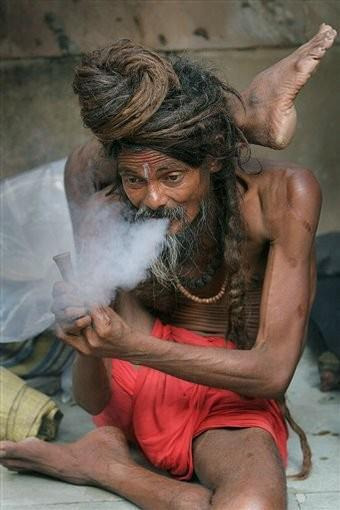
My favorite thing to talk about is how words are no longer necessary.
4 notes
·
View notes